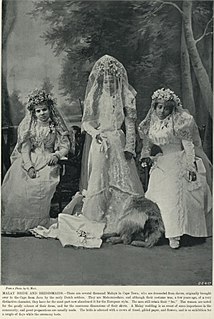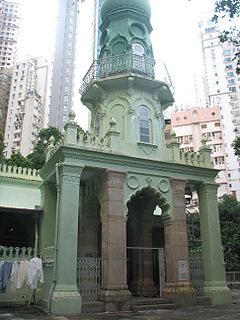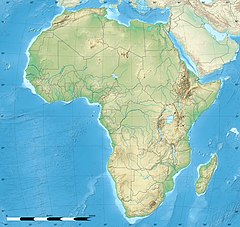
The Cape Colony, also known as the Cape of Good Hope, was a British colony in present-day South Africa named after the Cape of Good Hope, which existed from 1795 to 1802, and again from 1806 to 1910, when it united with three other colonies to form the Union of South Africa.
This article describes the history of the Australian colony and state of Victoria.

The first modern humans are believed to have inhabited South Africa more than 100,000 years ago. South Africa's prehistory has been divided into two phases based on broad patterns of technology namely the Stone Age and Iron Age. After the discovery of hominins at Taung and australopithecine fossils in limestone caves at Sterkfontein, Swartkrans, and Kromdraai these areas were collectively designated a World Heritage site. The first nations of South Africa are collectively referred to as the Khoisan, the Khoi Khoi and the San separately. These groups were displaced or sometimes absorbed by migrating Africans (Bantus) during the Bantu expansion from Western and Central Africa. While some maintained separateness, others were grouped into a category known as Coloureds, a multiracial ethnic group which includes people with shared ancestry from two or more of these groups: Khoisan, Bantu, English, Afrikaners, Austronesians, East Asians and South Asians. European exploration of the African coast began in the 13th century when Portugal committed itself to discover an alternative route to the silk road that would lead to China. In the 14th and 15th century, Portuguese explorers traveled down the west African Coast, detailing and mapping the coastline and in 1488 they rounded the Cape of Good Hope. The Dutch East India Company established a trading post in Cape Town under the command of Jan van Riebeeck in 1652, European workers who settled at the Cape became known as the Free Burghers and gradually established farms in the Dutch Cape Colony.

Abraham Fischer was a South African statesman. He was the sole Prime Minister of the Orange River Colony in South Africa, and when that ceased to exist joined the cabinet of the newly formed Union of South Africa.

Cape Malays also known as Cape Muslims or Malays, are a Muslim community or ethnic group in South Africa. They are the descendants of enslaved and free Muslims from different parts of the world who lived at the Cape during Dutch and British rule.
The following lists events that happened during 1834 in South Africa.

The Kaapse Klopse, formerly known as the Coon Carnival and officially called Cape Town Minstrel Carnival, is a Cape coloured minstrel festival that takes place annually on 2 January in Cape Town, South Africa. It is also referred to as Tweede Nuwe jaar. As many as 13,000 minstrels take to the streets garbed in bright colours, either carrying colourful umbrellas or playing an array of musical instruments. The minstrels are self-organised into klopse. The custom has been preserved since the mid-19th century.

British Kaffraria was a British colony/subordinate administrative entity in present-day South Africa, consisting of the districts now known as Qonce and East London. It was also called Queen Adelaide's Province.

The Bo-Kaap is an area of Cape Town, South Africa formerly known as the Malay Quarter. It is a former racially segregated area, situated on the slopes of Signal Hill above the city centre and is a historical centre of Cape Malay culture in Cape Town. The Nurul Islam Mosque, established in 1844, is located in the area.
The area known today as Cape Town has no written history before it was first mentioned by Portuguese explorer Bartholomeu Dias in 1488. The German anthropologist Theophilus Hahn recorded that the original name of the area was '||Hui !Gais' – a toponym in the indigenous Khoe language meaning "where clouds gather."

Izak David du Plessis, who published under the name I. D. du Plessis, was an Afrikaans-language writer. A successful writer in many genres, he is included among the Dertigers.

The Jamia Mosque is a mosque in Mid-Levels, Hong Kong. The mosque is the oldest mosque in Hong Kong. The neighboring streets Mosque Street and Mosque Junction are named after this mosque. Mufti Abdul Zaman is the main Imam of this Mosque and he leads prayers and taraweeh in the month of Ramadan.
Nigel Worden is a British/South African historian who has researched the history of Cape slavery and the social and cultural history of early colonial Cape Town. He is Emeritus Professor of History and retired from the Historical Studies department at the University of Cape Town, South Africa in 2016. He graduated from Jesus College Cambridge and was subsequently Research Fellow at Clare Hall, University of Cambridge and Lecturer in Commonwealth History at the University of Edinburgh. He holds MA and PhD degrees in History from the University of Cambridge and BA degrees in Art History and Linguistics from the University of South Africa.

The Auwal Mosque, alternatively spelled Awwal, Owal or Owwal, is a mosque in the Bo-Kaap neighbourhood of Cape Town, South Africa, recognised as the first mosque established in the country. It was constructed in 1794 during the first British occupation of the Cape on land belonging to Coridon van Ceylon, a Vryezwarten. Coridon's daughter, Saartjie van de Kaap, inherited the property that was being used as a warehouse, and donated it for the use as South Africa's first mosque. The mosque was constructed in 1794 with renovations done in 1907 and extensive renovations done in 1936. It is the first mosque to observe public prayers and is where Cape Muslim traditions and the Arabic-Afrikaans language were first taught. It remains a symbol for Muslims of the recognition of Islam and the freedom of slaves to worship.
The following is a timeline of the history of Cape Town in the Western Cape province of South Africa.

The Tana Baru Cemetery is a Muslim cemetery where some of the earliest and respected Muslim settlers of South Africa were buried. The cemetery is located in Bo-kaap, Cape Town.
Julia Frances Solly was a British suffragist, feminist and temperance activist. After her marriage, she moved to South Africa, where she became one of the most recognisable feminists in the Cape Colony. Advocating for suffrage, she co-founded the Cape Branch of the Women's Enfranchisement League (WEL), the first organisation in South Africa created to push for women's right to vote. Active as a pacifist, she was against both the Second Boer War and World War I, but believed that the Nazis must be stopped at all cost. She was also active in many social reform programs and was part of the purity movement. For her work on the National Council of Women, she was awarded the King George Silver Jubilee Medal in 1935.

Faldela Williams was a South African cook and cookbook writer whose books inspired generations of cooks after her to preserve the culinary heritage of South Africa's Cape Malay people.

The following outline is provided as an overview of and topical guide to Cape Town:
Johannes Joachim Lodewyk Smuts was a South African public official, businessman and the second Mayor of Cape Town.















